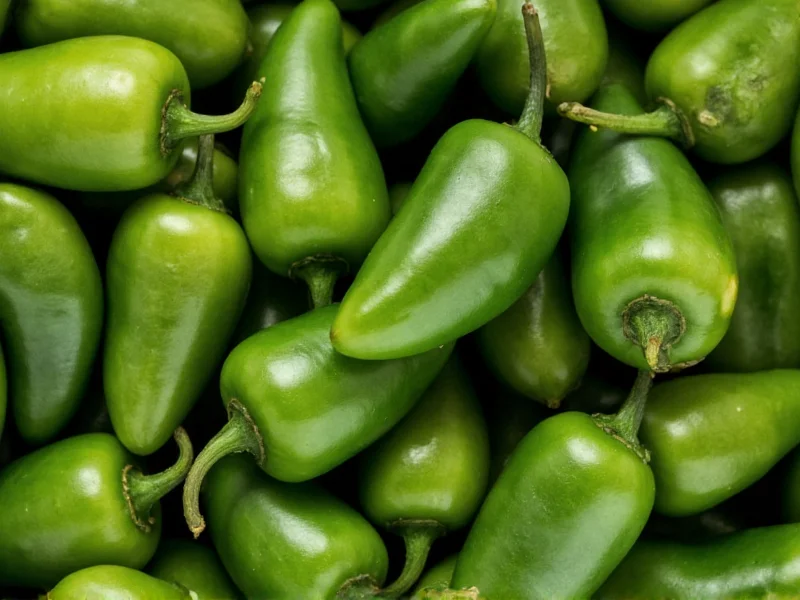Understanding the relationship between chipotle and jalapeño peppers is essential for anyone exploring Mexican cuisine or expanding their culinary spice knowledge. While they originate from the same pepper variety, their preparation methods create significant differences in flavor, appearance, and culinary applications. The confusion often stems from menu descriptions and grocery store labeling that don't clarify this important distinction.
What Exactly Is a Jalapeño Pepper?
Jalapeños are medium-sized chili peppers that originated in Mexico and are now cultivated worldwide. These peppers typically measure 2-3.5 inches long and range from bright green to deep red when fully ripe. Fresh jalapeños offer a grassy, bright flavor with moderate heat measuring between 2,500-8,000 Scoville Heat Units (SHU).
Grown on upright plants, jalapeños are harvested at various stages of ripeness. Green jalapeños are unripe and most commonly found in grocery stores, while red jalapeños indicate full ripeness with slightly sweeter flavor. These versatile peppers appear fresh in salsas, pickled as escabeche, or stuffed with cheese in dishes like jalapeño poppers.
The Transformation: From Jalapeño to Chipotle
The term "chipotle" (pronounced chee-POHT-lay) comes from the Nahuatl language, combining "chil" (chili) and "poctli" (smoked). This etymology reveals the critical process that transforms ordinary jalapeños into chipotles: smoking.
Traditional chipotle production involves:
- Selecting fully ripe red jalapeños
- Slow-smoking them over wood fires for several days
- Drying until they reach a leathery, flexible texture
This smoking process not only preserves the peppers but fundamentally alters their chemical composition, creating complex flavor compounds that give chipotles their signature smoky, earthy, and slightly sweet profile. The heat level remains similar to fresh jalapeños (2,500-8,000 SHU), though the smokiness can make the heat feel more intense.
Comparing Fresh Jalapeños and Chipotles
| Characteristic | Fresh Jalapeño | Chipotle Pepper |
|---|---|---|
| Origin | Raw jalapeño pepper | Smoked & dried jalapeño |
| Appearance | Bright green to red, smooth skin | Dark brown to black, wrinkled skin |
| Flavor Profile | Grassy, bright, vegetal | Smoky, earthy, slightly sweet |
| Texture | Crisp, juicy flesh | Leathery, flexible when rehydrated |
| Common Forms | Fresh, pickled, canned | Dried whole, in adobo sauce, powder |
| Shelf Life | 1-2 weeks refrigerated | Months to years when properly stored |
Culinary Applications: When to Use Each
Understanding the difference between chipotle and jalapeño is crucial for proper recipe execution. While fresh jalapeños provide bright heat in salsas, guacamole, and nachos, chipotles deliver deep smokiness essential to mole sauces, adobo marinades, and certain types of chili.
Chefs often make the mistake of substituting one for the other without considering how this changes the dish's flavor profile. A recipe calling for chipotles in adobo sauce requires that distinctive smokiness that fresh jalapeños simply cannot provide. Conversely, using chipotles where fresh jalapeños are specified would overwhelm the dish with smoke.
Common Misconceptions Clarified
Several persistent myths contribute to the confusion about whether chipotle is a jalapeño:
- Myth: Chipotle is a different pepper variety
Reality: Chipotles are exclusively made from jalapeños through smoking - Myth: All smoked peppers are chipotles
Reality: Only smoked jalapeños qualify as true chipotles; other smoked peppers have different names (like smoked serranos) - Myth: Chipotles are always hotter than jalapeños
Reality: The heat level remains similar, though the smokiness can make the heat feel more intense
Shopping and Storage Tips
When purchasing these peppers, understanding their forms helps make the right selection:
- Fresh jalapeños: Look for firm, bright green peppers without soft spots. Store in the refrigerator crisper drawer for up to 2 weeks.
- Dried chipotles: Should be flexible, not brittle. Store in an airtight container in a cool, dark place for up to a year.
- Chipotles in adobo: These canned peppers come submerged in a tangy tomato-based sauce. Once opened, transfer to a sealed container and refrigerate for up to 2 weeks.
For the most authentic flavor, seek out chipotles labeled "mejorados" which indicates they've been smoked using traditional methods with oak or mesquite wood, rather than industrial smoking processes.
Substitution Guidance
When recipes call for one but you only have the other, consider these thoughtful substitutions:
- Replacing fresh jalapeño with chipotle: Use 1/2 to 1 chipotle pepper (minced) per fresh jalapeño, plus a splash of lime juice to approximate the fresh flavor
- Replacing chipotle with fresh jalapeño: Use fresh jalapeño plus 1/4 teaspoon smoked paprika per pepper to mimic the smokiness
- For chipotle powder: Substitute with 1/2 teaspoon smoked paprika plus a pinch of cayenne per 1/4 teaspoon chipotle powder
Remember that these substitutions won't perfectly replicate the original ingredient but can help when you're between a recipe and an ingredient shortage.
Historical Context
The practice of smoking jalapeños dates back to pre-Hispanic Mexico, where indigenous peoples developed smoking as a preservation method before refrigeration existed. The Zapotec people of Oaxaca were particularly known for their smoking techniques. Spanish colonizers later adopted these methods, incorporating chipotles into the evolving fusion of Mexican cuisine.
Today, the town of San Martín Tilcajete in Oaxaca remains famous for its traditional chipotle production, where farmers still use time-honored smoking methods passed down through generations. This historical context helps explain why the distinction between fresh jalapeños and their smoked counterparts matters culturally as well as culinarily.











 浙公网安备
33010002000092号
浙公网安备
33010002000092号 浙B2-20120091-4
浙B2-20120091-4